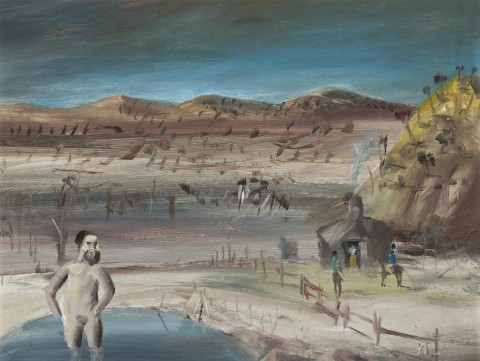THE QUESTIONING, 1954
SIDNEY NOLAN
oil on composition board
60.0 x 80.0 cm
signed with initial lower right: N
signed, dated and inscribed with title verso: The QUESTIONING / (KELLY SERIES) / NOLAN. / 10/2/54 / N
Private collection
Joseph Brown Gallery, Melbourne
Private collection
Christie’s, Melbourne, 14 March 1972, lot 78
Alan and Nola Geddes, Sydney
Estate of Nola Geddes, Sydney
Autumn Exhibition 1970, Joseph Brown Gallery, Melbourne, 2 – 23 March 1970, cat. 25 (illus. in exhibition catalogue)
Hughes, R., The Art of Australia, Penguin Books, Melbourne, revised edition 1970, p. 166
The Questioning, 1947, enamel on composition board, 90.7 x 121.1 cm, in the collection of the National Gallery of Australia, Canberra, gift of Sunday Reed 1977, illus. in Rosenthal, T.G., Sidney Nolan, Thames and Hudson, London, 2002, p. 77
Sidney Nolan was fascinated by the story of Ned Kelly, the infamous nineteenth-century bushranger, and over the course of his long career it was an enduring theme to which he returned repeatedly. Speaking to Elwyn Lynn about the significance of the subject within his oeuvre, Nolan imagined that it would continue until the end of his life, stating ‘I paint Kelly as part of Australia’s culture and mine … I’d like to think that the day before I died I’d paint a good Ned Kelly painting’.1
The first Kelly series was famously painted on the dining table at Heide,2 the home of John and Sunday Reed, between March 1946 and July 1947. It emerged after a period of intense research during which Nolan travelled to Glenrowan, the site of the Kelly gang’s last stand, as well as reading everything he could find on the subject, from first-hand accounts to contemporary newspaper coverage and the Royal Commission Report on the pursuit of the outlaws. This was characteristic of Nolan’s approach to any new subject and such was his fascination with Kelly at the time that his friend, the artist Albert Tucker, nicknamed him ‘Ned’.3 Now on permanent display at the National Gallery of Australia, these paintings were about more than true-crime drama however and, as John Reed so eloquently wrote, captured ‘both the landscape and man in relation to the landscape … [depicting a] profound harmony between symbol, legend and visual impact.’4
Nolan embarked on a second major series of Kelly paintings in the mid-1950s, by which time he had settled in England. The theme had lost none of its power during the preceding decade and Nolan produced an inspired body of work that showed him as a confident and accomplished artist. Painted in February 1954, The Questioning (Kelly Series), 1954 describes the same event as the 1947 version – when mounted troopers calling at a homestead during their search for the Kelly gang are directed to ask a figure bathing in a nearby dam – but Nolan has made various subtle changes which shift the emphasis of this painting and imbue it with a quiet intensity. The horizon line has been raised so that it is the landscape of scrubby growth and distant low hills that dominates the composition. The ominous grey sky reflected in the dam establishes the prevailing mood and the country between is described in a restrained palette of earthy colours deftly applied to the board with lively strokes of the brush. The bright yellow Ripolin which draws attention to the bathing figure and the mounted troopers in the earlier version is nowhere to be seen and rather than the human drama being the key focus, it is the relationship between the figures and their environment that emerges as most significant.
While this painting was not included in Nolan’s exhibition at London’s Redfern Gallery in May 1955, the critical response to the second Kelly series was unanimously positive. Institutional recognition soon followed with the purchase of After Glenrowan Siege, 1955 by the Museum of Modern Art, New York, and two years later, the Tate, London, acquired Glenrowan, 1956 – 57 from Nolan’s first large-scale survey exhibition at the Whitechapel Gallery. Paintings from the second series are also represented in numerous important public and private collections in Australia including: Kelly Crossing the Bridge, 1955 (National Gallery of Australia, Canberra), Ned Kelly, 1955 and Kelly, 1956 (Art Gallery of New South Wales, Sydney), Kelly with Horse, 1955 (National Gallery of Victoria, Melbourne) and After Glenrowan Siege no. 2, 1956 (TarraWarra Museum of Art Collection, Victoria).
1. Lynn, E. and Semler, B., Sidney Nolan’s Ned Kelly, Australian National Gallery, Canberra,1985, p. 11
2. Of the 27 paintings that comprise the first Kelly series, the exception to this is First-class Marksman 1946 (Art Gallery of New South Wales) that was painted at Stonygrad, the Warrandyte home of Danila Vassilieff. See Pearce, op. cit., p. 35. Sunday Reed gifted the paintings made at Heide to the Australian National Gallery, Canberra (now National Gallery of Australia) in 1977.
3. Reeder, W., ‘Nolan at Heide’, Reeder, W. (ed.), The Ned Kelly Paintings: Nolan at Heide 1946-47, exhibition catalogue, Museum of Modern Art at Heide, Melbourne, 1997, p. 11
4. Reed, J., ‘Statement’, Reeder, op. cit., p. 16
KIRSTY GRANT
